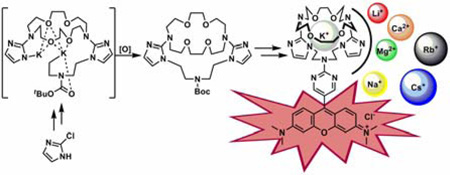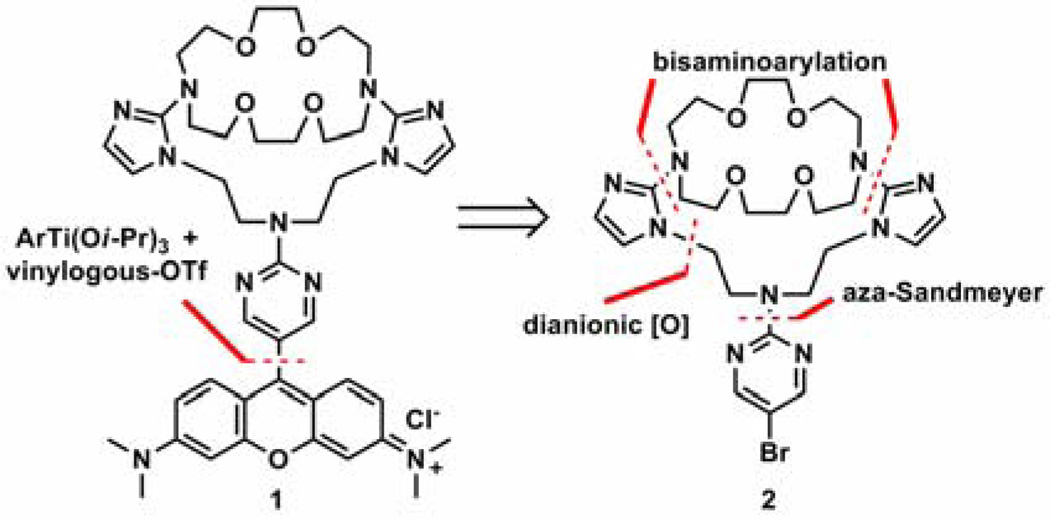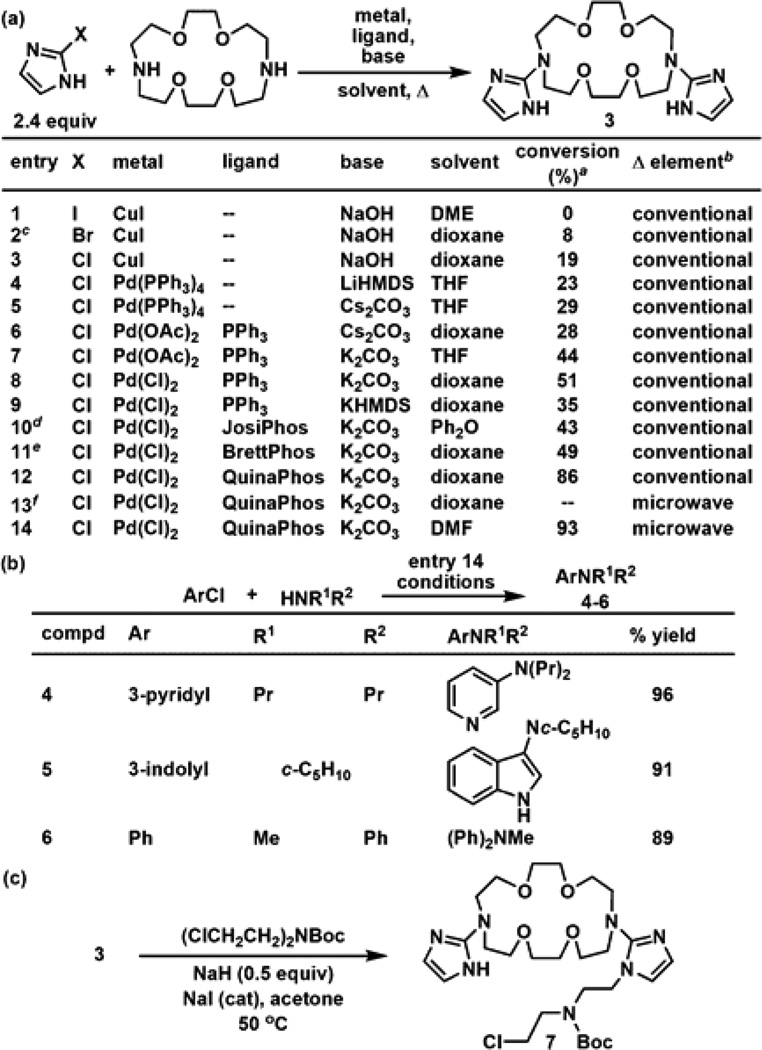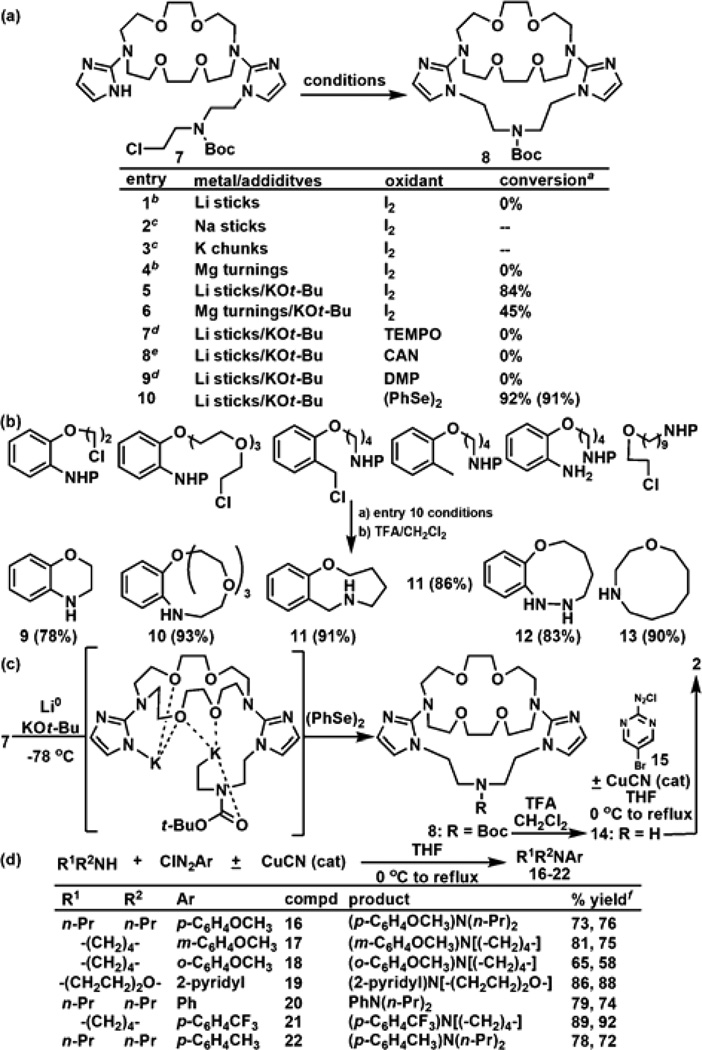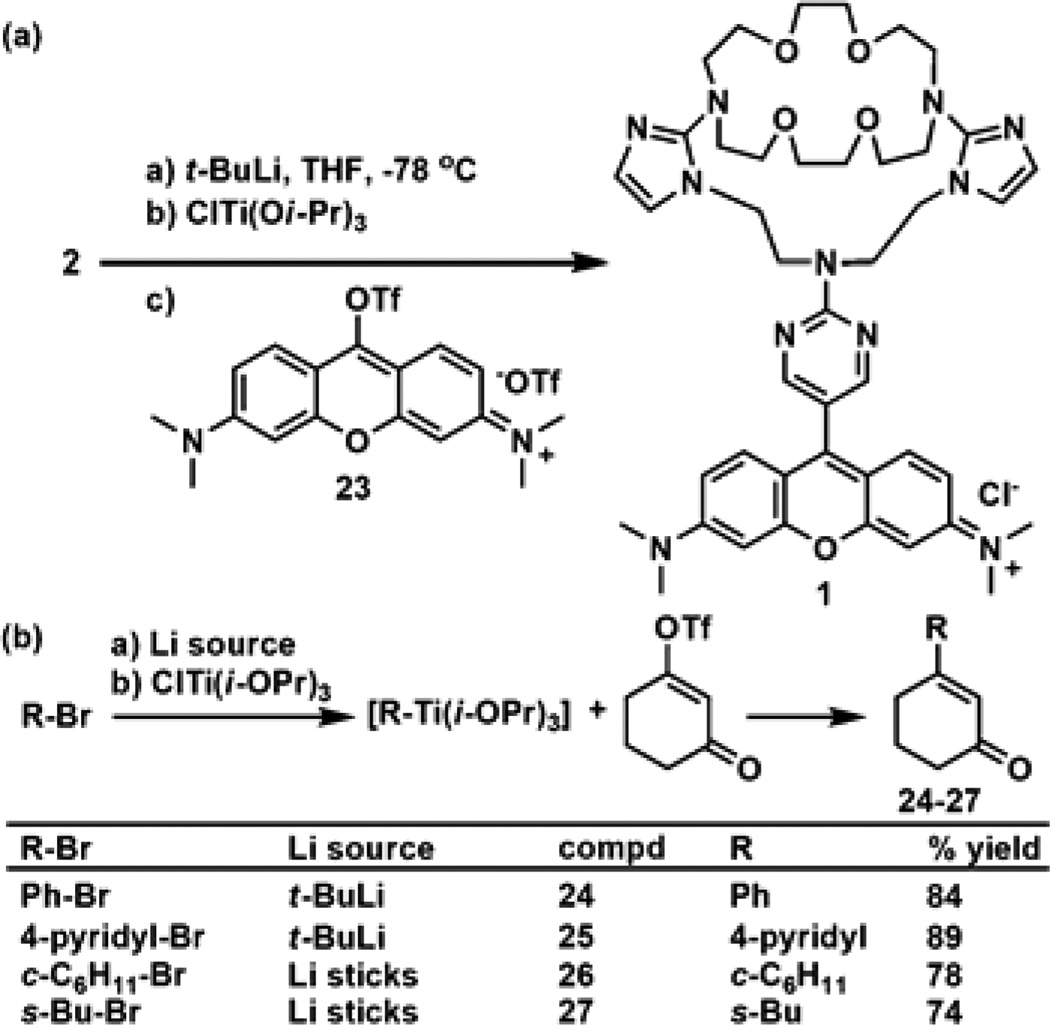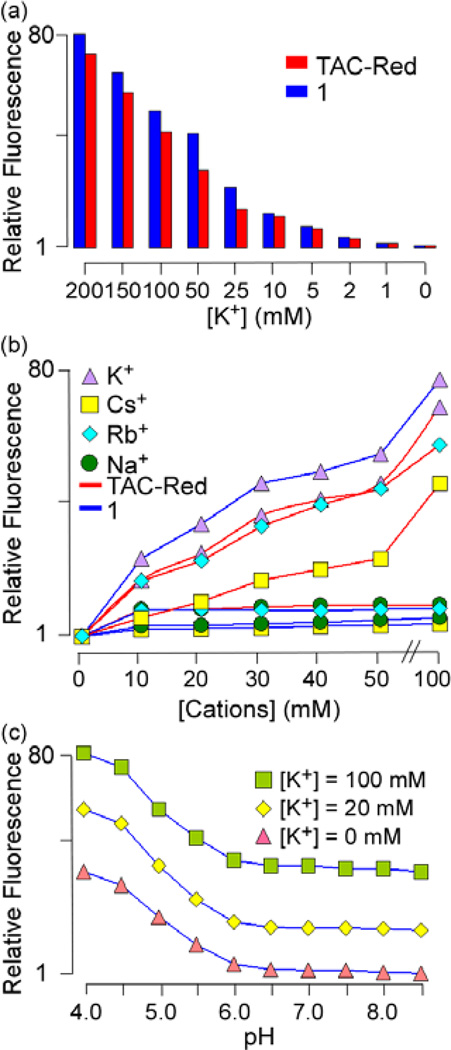Abstract
An efficient synthesis is reported that delivers in 5 steps in 52% overall yield a new structurally simplified fluorescent K+ sensor with improved K+ sensitivity and selectivity over existing K+ sensors. The synthesis procedure utilizes a new template-directed oxidative C-N bond forming macrocyclization reaction, and reports new approaches to Pd(0), Sandmeyer-like and metal-free aminoarylations, as well as organotitanium additions to vinylogous sulfonates.
Efficient syntheses of complex, biomedically-relevant compounds provide the impetus for novel reaction methodologies. 1 In the field of ion sensing, of great importance are fluorescent potassium (K+) indicators that function in aqueous media, and have good optical properties, high K+ sensitivity and selectivity, pH insensitivity, and, perhaps most importantly, a feasible synthetic route.2 K+ is a major analyte that plays a vital role in normal cell function and various diseases.3 Our laboratory and others have made advances in K+ biosensing, including the development of an aqueous-compatible sensor,4a an ionophore that is insensitive to pH in the range of 5–8,4b and a conjugated ionophore-chromophore system that by photo-induced electron transfer produced a 14-fold increase in fluorescence with increasing K+.4c,4d The reported synthetic methods for these sensors involve 12–16 steps (longest linear sequence 11–13 steps), which include two 21-membered macrocyclizations and a poor yielding two- to three-step ionophore-chromophore union late in the synthesis.4 Limited by these laborious routes, fine tuning the K+ sensitivity and selectivity of these sensors has not been done, nor have these sensors been widely available to biomedical scientists.
Herein, this report describes a concise synthesis of structurally simplified and functionally superior K+ sensor 1 via three interesting C-N bond forming reactions and an efficient ionophore-chromophore C-C bond forming reaction as shown in Figure 1. Highlights of this novel approach include a rapid microwave-mediated aminoarylation using a palladium-QuinaPhos catalyst, a template-directed macrocyclization representing a conformationally-unrestricted oxidative C-N bond forming reaction, the first example of employing a secondary amine in a Sandmeyer-like reaction, a metal-free aminoarylation, and a one-step organotitanium-mediated ionophore-chromophore forming reaction. Each of these transformations is applied not only to the synthesis of 1 but has also been extended to demonstrate additional examples of their scope and utility. The efficient synthesis route developed here should enable the development and application of K+ sensors for important biomedical applications, such as high-throughput screening / drug discovery,5a in vivo K+ imaging,5b artificial receptors,5c fiberoptic K+ sensing,5d and organellar K+ measurement.
Figure 1.
Structures and key disconnections of K+ sensor 1 and ionophore bromide precursor 2.
Our step-economical synthesis focused on simplifying and optimizing the K+ binding motif as well as improving the ionophore-chromophore union. Previous ionophores have shown greater that 30-fold selectivity for K+ over biological ions such as Ca2+, Mg2+, and, to a lesser extent, Na+.4 However, these sensors lack selectivity for the larger ions Cs+ and Rb+. We postulated that improved K+ binding affinity and selectivity could be achieved by decreasing the size of the ionophore cage by four atoms and using Lewis basic bisimidazoles in lieu of tolyl moieties. Additionally, we envisioned that replacing the methoxyethoxyphenyl motif with pyrimidine would likely maintain or improve affinity, and that ionophore bromide 2 as well as subsequent ionophore-chromophore conjugates would be more synthetically accessible than sensors derived from an ionophore aldehyde, the precursor used in prior syntheses.4
The function-oriented synthesis of 1 began with attempts towards a transition metal-mediated bisaminoarylation as shown in Figure 2a. Unfortunatley, established Cu(I)6a and Pd(0)6b,6c methods were unsuccessful in our hands as depicted in entries 2, 10, and 11. The halogen of the aryl halide, Pd(0) source and ligand, base, solvent, and heating element were all found to be critical components to obtain diimidazole 3 in high yield without requiring protection of the imidazole NH. Entry 14 highlights the conditions found which feature 2-chloroimidizole as the aryl halide, QuinaPhos as a new ligand, and microwave irradiation as a heat source to afford 3 in 93% yield. Additionally, these aminoarylation conditions afforded tertiary arylamines 4–6 in excellent yields in 20 min using a variety of aryl chlorides with acyclic and cyclic secondary amines. This aminoarylation was then followed by a Finkelstein-mediated mono-alkylation of diimidazole 3 with tert-butyl bis(2-chloroethyl)carbamate to provide alkyl chloride 7 (87%) as shown in Figure 2c.
Figure 2.
(a) The conditions shown in entry 14 used QuinaPhos and microwave irradiation (20 min) to afford 3 (93%); (b) The utility of this aminoarylation reaction is demonstrated in the syntheses of 4–6; (c) Finkelstein alkylation of 3 to afford 7 (87%). Footnotes: aDetermined by LCMS. The conversion % value in entry 14 also represents the isolated yield. bConventionally heated reactions occured in an oil bath at reflux for 18 h. Microwave reactions were heated to 95 °C for 20 min. Conditions used from cRef. 6a; dRef. 6b; eRef. 6c. fDesired T could not be achieved.
With an efficient two-step route to 7, effort then focused on the synthesis of ionophore bromide 2 as shown in Figure 3. Unfortunately, various intramolecular N-alkylation attempts produced intermolecular or elimination products as shown in Chart 1 of the Supporting Information. Inspired by recent dianionic oxi dations on conformationally-constrained systems,7 we envisioned that deprotonating the N-H of 7 coupled with a metal-halogen exchange would afford a dimetalated intermediate that, in the presence of several chelating neighboring groups, would bring both dimetalated moieties in close proximity thereby enabling a template-directed oxidative macrocyclization. As depicted in Figure 3a, several metals and oxidants were assessed, however many of these were unsuccessful because of decomposition of the starting material, protonation of the chloride-derived anion, and/or dimerization. Dilithiation with Li sticks, followed by trans-metallation with KOt-Bu presumably generated an organodipotassium intermediate that was subsequently oxidized with diphenyl diselenide to afford 8 (91%) containing the complete macrocyclic backbone of 2. We believe that this template-directed macrocyclization, which presumably occurs via polar or SET mechanisms in accords with Sarpong’s findings,7b is a new example of an oxidative C-N bond formation from a conformationally-unrestricted system.
Figure 3.
(a) The conditions shown in entry 10 used Li sticks/KOt-Bu and (PhSe)2 to afford 8 in an isolated yield of 91% yield. (b) Utility of this oxidative cyclization is demonstrated in the syntheses of cyclic secondary amines 9–13 (P = Boc). (c) Synthesis of ionophore 2 featuring an oxidative C-N bond forming cyclization and either a Sandmeyer-like reaction (+CuOAc) or a metal-free aminoarylation (−CuOAc) with a secondary amine. (d) Utility of these aminoarylation conditions used in Figure 2c is demonstrated in the synthesis of tertiary arylamines 16–22. Footnotes: aDetermined by LCMS. Isolated yield shown in parenthesis. bMajor product was a dimer. cStarting material recovered. dMajor product was an alkene. eMajor product was an alkane. fFirst/second values rerpresent the % yield obtained with/without CuOAc (cat).
To investigate the scope of this reaction, a small collection of cyclic secondary amines was synthesized as shown in Figure 3b. These conditions afforded 6- to 15-membered cyclic alkoxyamines 9–11 and 13 as well as alkoxyhydrazine 12 in very high yields. Interestingly, the anion source could be generated from either a lithium-halogen exchange or a deprotonation of an o-tolyl C-H or an aniline N-H. Attempts to prepare a cyclic secondary amine from Boc-protected 12-chlorododecylamine were unsuccessful, suggesting that an in-chain “RCH2K”-chelating motif is an essential component.
Returning to the synthesis of ionophore 2, Boc-protected amine 8 was treated with TFA followed by precipitation with aqueous sodium carbonate to quantitatively afford free amine 14. A solution containing diazonium salt 15 (prepared from the oxidation of 5-bromo-2-aminopyrimidine) was then cannulated into a THF solution of amine 14 with catalytic CuOAc and warmed to reflux temperature to afford 2 (78%). When catalytic CuOAc is not used,8 the ionophore bromide 2 is obtained in 86% yield. These represent, to our knowledge, the first examples of a secondary amine participating in a Sandmeyer-like or a metal-free aminoarylation from aryldiazonium salts.9 To investigate the scope of this aminoarylation reaction with and without catalytic copper(I), amines 16–22 were prepared in 58–89% yield (Figure 3d). Interestingly, electron deficient heteroaryl diazonium salts afforded higher % yield than electron efficient systems.
Having devised an efficient route to ionophore bromide 2 (see Figure 1), our attention turned towards the ionophore-chromophore union as shown in Figure 4a. In prior reports, this union required several steps to afford a K+ sensor because of the need to construct the chromophore around the ionophore aldehyde carbon.4 In order to accomplish this union in one transformation, we envisioned an organometallic addition to an activated xanthylium such as the vinylogous sulfonate 23. Indeed, treatment of 2 with t-BuLi, followed by ClTi(Oi-Pr)3, delivered the corresponding organotitanium reagent. Quenching this anion with a chilled solution of xanthylium triflate 23 (prepared from the corresponding xanthone)10 gave 1 in 82% yield. Since there are no examples, to our knowledge, of organotitanium additions to vinylogous systems in the literature, the general utility of this transformation was further demonstrated as shown in Figure 4b. Organotitanium reagents (1.0 equiv) derived from aryl or alkyl bromides were added to a model vinylgous sulfonate and afforded 3-substituted cyclohexenones 24–27 in an average yield of 81% with expected control of chemo- and regioselectivity.
Figure 4.
(a) One-step synthesis of sensor 1 from ionophore bromide 2 via an organotitanium intermediate to vinylogous sulfonate 23. (b) Cyclohexenones 24–27 were prepared with an average yield of 81% with complete chemo- and regioselectivity, thereby demonstrating the utility of this organotitanium addition to a model vinylogous sulfonate.
The K+ sensitivity and specificity of sensor 1 were compared to reference sensor TAC-Red4c as shown in Figure 5. TAC-Red and 1 (each at 7 µM) were dissolved in pH 7 HEPES buffer balanced with KCl/NaCl to maintain constant ionic strength at 200 mM. The structurally simplified 1 was slightly more sensitive to K+ than TAC-Red as shown in Figure 5a. Figure 5b shows that 1 was remarkably more selective for K+ vs. Cs+ or Rb+ than TAC-Red, and had comparable low sensitivity to Na+, Li+, Mg2+, and Ca2+ (the latter three ions not shown in Fig. 5b). Finally, 1 had comparable pH insensitivity to TAC-Red at pH greater than 6 as shown in Figure 5c. These results are likely attributed to 1 having a smaller ionophore cage that excludes the larger cations like Cs+ and Rb+ yet brings Lewis basic nitrogen and oxygen atoms in a favorable position for K+ binding.
Figure 5.
(a) Fluorescence emission at 570 nm of 1 (blue) and TAC-Red4c (red) at various [K+]. (b) Fluorescence at 570 nm of 12 (blue line) and TAC-Red (red line) in the presence of indicated cations. (c) Fluorescence of 1 as a function of pH at indicated [K+]. Samples in (a–c) were excited at 480 nm and solutions were balanced with NaCl or choline chloride to maintain a constant ionic strength of 200 mM.
In summary, the streamlined synthesis reported here, which represents over a two-fold decrease in steps compared to TAC-Red, affords the functionally superior yet structurally simplified K+ sensor 1 in 52% overall yield with the longest linear sequence being 4–5 steps. Additionally, this report highlights new ligand and microwave conditions for aminoarylations, a C-N bond forming oxidative cyclization reaction to generate cyclic secondary alkoxyamines, the first example of secondary amines in Sandmeyer-like reactions, new examples of metal-free aminoarylations, and an efficient route to chromophore conjugates via an organotitanium addition to vinylogous sulfonates. Creating bioconjugates derived from sensor 1 to measure [K+] in major molecular, cellular, translational, and clinical applications will be reported in due course.
Supplementary Material
Acknowledgment
This research is dedicated in remembrance of Prof. Aaron D. Mills (University of Idaho). Helpful discussions with Profs. Mark J. Kurth and Dean J. Tantillo (University of California, Davis) are gratefully acknoweldged. This work was supported by NIH grants EB00415, DK86125, DK35124, HL73856, EY13574, DK72517, and grants from the Cystic Fibrosis Foundation and Guthy-Jackson Charitable Foundation.
Footnotes
Supporting Information Available: Experimental procedures and analytical data for all new compounds. This material is available free of charge via the Internet at http://pubs.acs.org.
References
- 1.Wender PA, Verma VA, Paxton TJ, Pillow TH. Acc. Chem. Res. 2008;41:40–49. doi: 10.1021/ar700155p. [DOI] [PubMed] [Google Scholar]
- 2.(a) Callan JF, de Silva AP, Magri DC. Tetrahedron. 2005;61:8551–8588. [Google Scholar]; (b) de Silva AP, Gunaratne HQN, Gunnlaugsson T, Huxley AJM, McCoy P, Rademacher JT, Rice TE. Chem. Rev. 1997;97:1515–1566. doi: 10.1021/cr960386p. [DOI] [PubMed] [Google Scholar]
- 3.(a) Sack JT, Shamotienko O, Dolly JO. J. Gen. Physiol. 2008;131:415–420. doi: 10.1085/jgp.200709939. [DOI] [PMC free article] [PubMed] [Google Scholar]; (b) Dudev T, Lim C. J. Am. Chem. Soc. 2009;131:8092–8101. doi: 10.1021/ja900168k. [DOI] [PubMed] [Google Scholar]; (c) Frolov RV, Brelim IG, Saptal S. J. Biol. Chem. 2008;283:1518–1524. doi: 10.1074/jbc.M708100200. [DOI] [PubMed] [Google Scholar]; (d) Schroeder BC, Bjorn C, Kubisch C, Stein V, Jentsch TJ. Nature. 1998;396:687–690. doi: 10.1038/25367. [DOI] [PubMed] [Google Scholar]; (e) Alper SL. Annu. Rev. Physiol. 2002;64:899–923. doi: 10.1146/annurev.physiol.64.092801.141759. [DOI] [PubMed] [Google Scholar]; (f) Rosenhouse-Dantsker A, Sui JL, Zhao Q, Rusinova R, Rodriguez-Menchaca AA, Zhang Z, Logothetis DE. Nat. Chem. Biol. 2008;4:624–631. doi: 10.1038/nchembio.112. [DOI] [PMC free article] [PubMed] [Google Scholar]
- 4.(a) Namkung W, Padmawar P, Mills AD, Verkman AS. J. Am. Chem. Soc. 2008;130:7794–7795. doi: 10.1021/ja8014499. [DOI] [PMC free article] [PubMed] [Google Scholar]; (b) He H, Mortellaro MA, Leiner MJP, Fratz RJ, Tusa JK. J. Am. Chem. Soc. 2003;125:1468–1469. doi: 10.1021/ja0284761. [DOI] [PubMed] [Google Scholar]; (c) Padmawar P, Yao X, Bloch O, Manley GT, Verkman AS. Nat. Methods. 2005;2:825–827. doi: 10.1038/nmeth801. [DOI] [PubMed] [Google Scholar]; (d) Magzoub M, Padmawar P, Dix JA, Verkman AS. J. Phys. Chem. B. 2006;110:21216–21221. doi: 10.1021/jp0633392. [DOI] [PubMed] [Google Scholar]
- 5.(a) Dittrich PS, Man A. Nat. Rev. Drug Discovery. 2006;5:210–218. doi: 10.1038/nrd1985. [DOI] [PubMed] [Google Scholar]; (b) Trachtenberg JT, Chen BE, Knott GW, Feng G, Sanes JR, Welker E, Svoboda K. Nature. 2002;420:788–794. doi: 10.1038/nature01273. [DOI] [PubMed] [Google Scholar]; (c) Xia WS, Schmehl RH, Li C. J. Am. Chem. Soc. 1999;121:2319–2320. [Google Scholar]; (d) Xia WS, Schmehl RH, Li C. J. Am. Chem. Soc. 1999;121:2319–2320. [Google Scholar]
- 6.(a) Job GE, Buchwald SL. Org. Lett. 2002;4:3703–3706. doi: 10.1021/ol026655h. [DOI] [PubMed] [Google Scholar]; (b) Shen Q, Ogata T, Hartwig JF. J. Am. Chem. Soc. 2008;130:6586–6596. doi: 10.1021/ja077074w. [DOI] [PMC free article] [PubMed] [Google Scholar]; (c) Fors BP, Watson DA, Biscoe MR, Buchwald SL. J. Am. Chem. Soc. 2008;130:13552–13554. doi: 10.1021/ja8055358. [DOI] [PMC free article] [PubMed] [Google Scholar]
- 7.(a) Bisai A, West SP, Sarpong R. J. Am. Chem. Soc. 2008;130:7222–7223. doi: 10.1021/ja8028069. [DOI] [PubMed] [Google Scholar]; (b) West SP, Bisai A, Lim AD, Narayan RR, Sarpong R. J. Am. Chem. Soc. 2009;131:11187–11194. doi: 10.1021/ja903868n. [DOI] [PubMed] [Google Scholar]
- 8.CuOAc was chosen over CuCN, as the undesired benzonitrile was observed as a minor product and poisonous HCN is a likely byproduct. When stoichiometric CuCN was used, the benzonitrile was obtained in 60% yield. Beletskaya’s conditions afforded the benzonitrile in 89% yield: Beletskaya IP, Sigeev AS, Peregudov AS, Petrovskii PV. J. Organometal. Chem. 2004;689:3810–3812..
- 9.The Sandmeyer reaction implies a radical process involving Cu(I) or other metals. Presumably, this happens with this Cu(I) version. However, metal-free aminoarylations occur with aryldiazonium salts using thiols, water, or iodide. It is not known, to our knowledge, whether these metal-free versions occur via a radical, ipso substitution, or dissociative mechanism. For metal-free versions, see: Filimonov VD, Trusova M, Postnikov P, Krasnokutskaya EA, Lee YM, Hwang HY, Kim H, Chi K-W. Org. Lett. 2008;10:3961–3964. doi: 10.1021/ol8013528..
- 10.Kenmoku S, Urano Y, Kojima H, Nagano T. J. Am. Chem. Soc. 2007;129:7313–7318. doi: 10.1021/ja068740g. [DOI] [PubMed] [Google Scholar]
Associated Data
This section collects any data citations, data availability statements, or supplementary materials included in this article.



